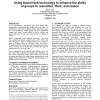277 search results - page 16 / 56 » Designing interfaces that influence group processes |
EICS
2010
ACM
14 years 14 days ago
2010
ACM
In Human Computer Interaction, plasticity refers to the capacity of User Interfaces (UIs) to withstand variations of context of use while preserving quality in use. Frequently, in...
NORDICHI
2004
ACM
14 years 25 days ago
2004
ACM
It is critical to the success of a system that appropriate and representative users are involved in the development work. However, the process of identifying and selecting users h...
CHI
2010
ACM
14 years 2 months ago
2010
ACM
In many developing countries such as India and China, low educational levels often hinder economic empowerment. In this paper, we argue that mobile learning games can play an impo...
SIGMOD
2009
ACM
14 years 7 months ago
2009
ACM
We are experiencing a new Social Web, where people share, communicate, commiserate, and conflict with each other. As evidenced by systems like Wikipedia, twitter, and delicious.co...
ACMDIS
2006
ACM
13 years 11 months ago
2006
ACM
Randomness is being harnessed in the design of some interactive systems. This is observed in random blogs, random web searching, and in particular Apple's iPod Shuffle. Yet t...

